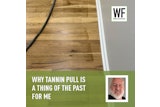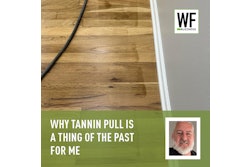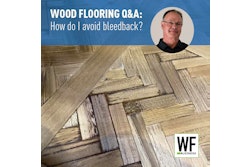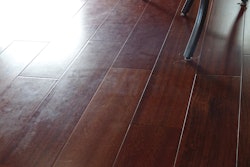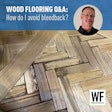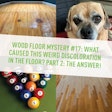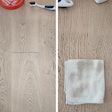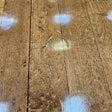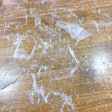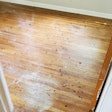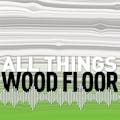The Problem
I received a call from the local builder warranty corporation to inspect a hardwood floor for which the finish was peeling. The homeowners deemed the product defective and insisted it be replaced.
The Procedure
The product was a factory-finished solid oak floor installed throughout the main floor of the home. They said the finish started exhibiting signs of peeling—chipping off the surface—a couple of months after they took possession of the home. The builder then set up an inspection with a distributor's rep. The rep inspected the floor and submitted a report stating it was not the factory finish that was peeling, but rather a subsequent coat of finish that had been applied. The homeowners still insisted it was the factory finish of the floor, and I was contacted to assess the problem.
The Cause
Upon entering the home, I observed the finish was flaking more than it was peeling. In the flaking areas, the removed finish had a milky white or frosted appearance. I could easily scratch the finish off the surface of the floor using my fingernail, but it did not go to bare wood. Instead, what was left under the flaking finish was a smooth and hard finish consistent with what a factoryfinished floor should be like. Upon further examination of the floor, I noticed swirl marks under the finish that went across several adjacent boards, plus there was an abundance of debris (mainly dust and some hair) cured in the finish. Again, this is not consistent with a factory-finished floor. Then, I removed a couple of floor vents and found that finish had run down the edges of the boards around the vent. Using a quarter, I could easily scratch the floor in random areas and make finish flake off. The finish that was exposed under the floor did not flake at all.
In the end, the homeowners did admit to having the floor recoated before they moved in (but after possession), as they felt an additional coat of urethane would seal the edges of the boards to better protect the floor.
How to Fix the Floor
The remedy for this problem was to completely resand and refinish the floor. The floor did not warrant replacement, as it was a ¾-inch solid tongue-and-groove floor, and the wear layer would allow for multiple resandings. Buffing the floor again would not have remedied the problem, as it would not have removed all of the site-applied finish.
In the Future
Most of today's factory-finished floors have aluminium oxide or some form of mineral mixed into the finish on the topcoat or previous coats. This gives the floor superior protection against wear and tear. The only problem with these types of finishes is that most cannot be properly mechanically abraded by buffing in order to prepare them for an additional coat of finish. There are some dustless recoating products on the market specifically designed for use over finishes such as aluminium oxide; these products allow for proper adhesion between the factory finish and the new finish. Prior to recoating, it's always best to contact the manufacturer of the floor to ask if buffing and recoating their product is possible. If the manufacturer is unknown, do a test application in an inconspicuous area first. Keep in mind that recoating a factory-finished floor will void most manufacturers' finish warranties. Although most of today's factory finishes are extremely durable, they too can exhibit wear patterns over time in high traffic areas. Recoating is possible, but do your homework first.









